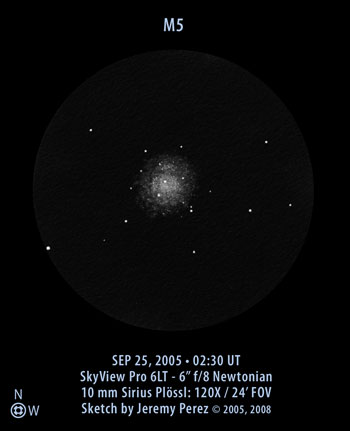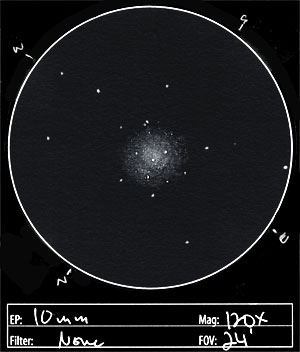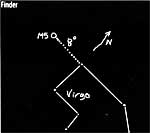
Click image for larger version.
The above sketch is an update to the original to clean it up and update formatting. The original is shown below.

Observation Notes:
 This is a huge and structurally interesting globular cluster. The core is compact and clumpy in places. The outer halo is extensive, and is also striated and clumpy. The impression is of a rose petal from above. Sandy granularity was evident fully across its surface. The loose outer halo seemed to flow off to the north like a south wind was hitting it. The extent seemed to be 4′ across. A very beautiful cluster.
This is a huge and structurally interesting globular cluster. The core is compact and clumpy in places. The outer halo is extensive, and is also striated and clumpy. The impression is of a rose petal from above. Sandy granularity was evident fully across its surface. The loose outer halo seemed to flow off to the north like a south wind was hitting it. The extent seemed to be 4′ across. A very beautiful cluster.
Object Information:
M5 is a distinctly elliptical globular cluster that elongates at a PA of 50�, which is roughly SE to SW. It is considered to be one of the oldest globular clusters with an age of 13 billion years. It is also one of the larger, with a diameter of 165 light years. It lies 24,500 light years away, and although it is 23′ in diameter, its visual extent is more like 10′ to 12′. The cluster is receding from us at about 52 km/sec. M5 contains a relatively large number of variable stars at 105.
M5 was first first discovered by Gottfried Kirch and his wife Maria Margarethe in 1702 while observing a comet. Charles Messier made his independent re-discovery in 1764. William Herschel first resolved it into stars in 1791.
| Subject | M5 (NGC 5904) |
| Classification | Globular Cluster (Class V) |
| Position* | Serpens [RA: 15:18:36 / Dec: +02:05:00] |
| Size* | 23.0′ |
| Brightness* | 5.6 |
| Date/Time | September 25, 2005 – 7:30 PM (September 26, 2005 – 02:30 UT) |
| Observing Loc. | Flagstaff, AZ – Home |
| Instrument | Orion SVP 6LT Reflector (150 mm dia./1200 mm F/L) |
| Eyepieces/Mag. | 10 mm (120X) |
| Conditions | Clear, mostly calm, 67°F |
| Seeing | ~3-4/10 |
| Transparency | Mag 5.8 NELM |
| Sources | SEDS |
*Based on published data.